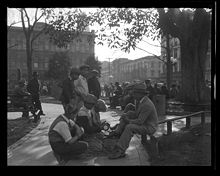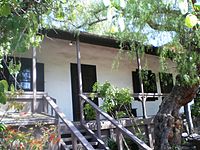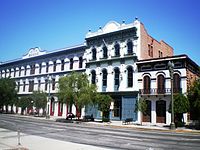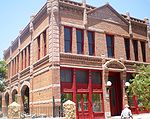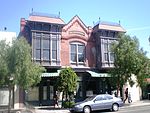- Los Angeles Plaza Historic District
-
Los Angeles Plaza Historic District
 La Placita Church
La Placita ChurchLocation: Los Angeles, California Coordinates: 34°3′25″N 118°14′16″W / 34.05694°N 118.23778°WCoordinates: 34°3′25″N 118°14′16″W / 34.05694°N 118.23778°W Architect: Unknown Architectural style: No Style Listed Governing body: State NRHP Reference#: 72000231[1] Added to NRHP: November 3, 1972 The Los Angeles Plaza Historic District, also known as El Pueblo de Los Angeles State Historic Park, is a historic district located at the oldest section of Los Angeles, known for many years as "El Pueblo de la Reina de Los Angeles". The district, centered on the old plaza, was the city's center under Spanish (1781–1821), Mexican (1821–1847) and United States (after 1847) rule through most of the 19th Century. The area was designated a state historic monument in 1953 and listed on the National Register of Historic Places in 1972.
History
Founding of the Pueblo
A plaque across from the Old Plaza commemorates the founding of the city. It states: "On September 4, 1781, eleven families of pobladores (44 persons including children) arrived at this place from the Gulf of California to establish a pueblo which was to become the City of Los Angeles. This colonization ordered by King Carlos III was carried out under the direction of Governor Felipe de Neve." The small town received the name El Pueblo de Nuestra Señora Reina de los Ángeles sobre El Rio Porciuncula, Spanish for The Town of Our Lady Queen of the Angels on the Porciuncula River. The original pueblo was built to the southeast of the current plaza along the Los Angeles River. In 1815, a flood washed away the original pueblo, and it was rebuilt farther from the river at the location of the current plaza.[2]
Growth of the Pueblo
During its first 70 years, the Pueblo grew slowly from 44 in 1781 to 1,615 in 1850—an average of about 25 persons per year. During this period, the Plaza Historic District was the Pueblo's commercial and social center. In 1850, shortly after California became part of the United States, Los Angeles was incorporated as a city. It experienced a major boom in the 1880s and 1890s, as its population grew from 11,200 (1880) to 50,400 (1890) and 102,500 in 1900. As the City grew, the commercial and cultural center began to move south away from the Plaza, along Spring Street and Main Street. In 1891, the Los Angeles Times reported on the move of the city's center:
"The geographical center of Los Angeles is the old plaza, but that has long since ceased to be the center of population. ... While at one time most of the population was north of the plaza, during the past ten years 90 per cent of the improvements have gone up in the southern half of the city. ... These are solid facts which it is useless to attempt to ignore by playing the ostrich acts and level-headed property holders in the northern part of the city are beginning to ask themselves seriously what is to be done to arrest or at least delay the steady march of the business section from the old to the new plaza on Sixth Street ..."[3]
Preservation as a historic park
The 44 acres (180,000 m2) surrounding the Plaza and constituting the old pueblo have been preserved as a historic park roughly bounded by Spring, Macy, Alameda and Arcadia Streets, and Cesar Chavez Boulevard (formerly Sunset Boulevard). There is a visitors center in the Sepulveda House, and a volunteer organization known as Las Angelitas del Pueblo provide tours of the district.
The district includes the city's oldest and most historic structures clustered around the old plaza. The buildings of greatest historical significance include Nuestra Señora La Reina de Los Angeles Church (1822), Avila Adobe (1818) (the city's oldest surviving residence), the Olvera Street market, Pico House (1870), and the Old Plaza Fire Station (1884). Four of the buildings have been restored as museums. Archaeological excavations in the Pueblo have uncovered artifacts from the indigenous period (before 1781), the Spanish colonial era (1781–1821), the Mexican era (1821–1847), and the first century of the American era (1850s–1940s), including animal bones, household goods, tools, bottles, and ceramics.[4]
The district was designated as a state monument in 1953,[5] and listed on the National Register of Historic Places in 1972.
Major sites
The Plaza
At the center of the Historic District is the old plaza itself. It has been described as "the focal point" of the state historic park, symbolizing the city's birthplace and "separating Olvera Street's touristy bustle from the Pico-Garnier block's empty buildings."[6] Built in the 1820s, the plaza was the city's commercial and social center. It remains the site of many festivals and celebrations. The plaza has large statues of three important figures in the city's history: King Carlos III of Spain, the monarch who ordered the founding of the Pueblo de Los Angeles in 1780; Felipe de Neve, the Spanish Governor of the Californias who selected the site of the Pueblo and laid out the town; and Father Junípero Serra, founder and first head of the Alta California missions. In addition to this, the plaza itself has been made a monument to the original forty-four settlers and the four soldiers who accompanied them. A large plaque listing their names was erected in the plaza, and later plaques dedicated to the individual eleven families were placed in the ground encircling the gazebo in the center of the plaza.
La Placita Church
The parish church in the Plaza Historic District, known as La Iglesia de Nuestra Señora la Reina de Los Ángeles (The Church of Our Lady the Queen of the Angels), was founded in 1814, though the structure was not completed and dedicated until 1822. The present church dates from 1861.[7] The church was one of the first three sites designated as Historic Cultural Monuments by the City of Los Angeles,[8] and has been designated as a California Historical Landmark[9]
Olvera Street
Olvera Street, known for its Mexican marketplace, was originally known as Wine Street. In 1877, it was extended and renamed in honor of Augustín Olvera, a prominent local judge. Many of the Plaza District's Historic Buildings, including the Avila Adobe and Sepulveda House are located on Olvera Street. In 1930, it was converted by local merchants into the colorful marketplace that remains today.
Avila Adobe
The Avila Adobe was built in 1818 and is the oldest surviving residence in Los Angeles. It is located in the paseo of Olvera Street and was built by Francisco Avila, a wealthy cattle rancher. Its adobe walls are 2½ to 3 feet (0.91 m) thick. U. S. Navy Commodore Robert Stockton took it over as his temporary headquarters when the United States first occupied the city in 1846. The adobe is listed on the National Register of Historic Places and is California State Landmark No. 145.
Plaza Substation
The Plaza Substation was part of the electric streetcar system operated by the Los Angeles Railway. Completed in 1904, the substation provided electricity to power the yellow streetcars. When the streetcar system closed, the building was converted to other uses. The substation is one of the two buildings in the district that is itself separately listed in the National Register of Historic Places. (The Avila Adobe is the other.)
Old Plaza Firehouse
The Old Plaza Firehouse is the oldest firehouse in Los Angeles. Built in 1884, it operated as a firehouse until 1897. The building was thereafter used as a saloon, cigar store, poolroom, "seedy hotel", Chinese market, "flop house", and drugstore.[10] The building was restored in the 1950s and opened as a firefighting museum in 1960.
Pico House
Pico House was a luxury hotel built in 1870 by Pío Pico, a successful businessman who was the last Mexican Governor of Alta California. With indoor plumbing, gas-lit chandeliers, a grand double staircase, lace curtains and a French restaurant, the Italianate three-story, 33-room hotel was the most elegant hotel in Southern California. It had a total of nearly eighty rooms. The Pico House is currently listed as a California Historical Landmark (No. 159).
Merced Theater
The Merced Theater, completed in 1870, was built in an Italianate style and operated as a live theater from 1871 to 1876. When the Woods Opera House opened nearby in 1876, the Merced ceased being the city's leading theater.[11] Eventually, it gained an "unenviable reputation" because of "the disreputable dances staged there, and was finally closed by the authorities."[12]
Masonic Hall
Masonic Hall was built in 1858 as Lodge 42 of the Free and Accepted Masons. The building was a painted brick structure with a symbolic "Masonic eye" below the parapet. In 1868, the Masons moved to larger quarters further south. Afterward, the building was used for many purposes, including a pawn shop and boarding house. It is the oldest building in Los Angeles south of the Plaza.
Garnier Building
The Garnier Building was built in 1890 and was part of the city's original Chinatown. The southern portion of the building was demolished in the 1950s to make way for the Hollywood Freeway. The Chinese American Museum is now located in the Garnier Building.
Sepulveda House
Sepulveda House is a 22-room Victorian house built in 1887 in the East lake style. The original structure included two commercial businesses and three residences. It is now the site of the Plaza District's Visitors' Center, which includes an 18-minute video of the Pueblo's early history.
Pelanconi House
Pelanconi House, built in 1857, is the oldest surviving brick house in Los Angeles.[13] In 1930, it was converted into a restaurant called La Golondrina, which is the oldest restaurant on Olvera Street.[14]
Plaza Methodist Church
Built in 1926, the Plaza Methodist Church was built on the site of the adobe once owned by Agustín Olvera, the man for whom Olvera Street was named.
Juan Bautista de Anza National Historic Trail
The Pueblo de Los Angeles is part of the tour sights of the Juan Bautista de Anza National Historic Trail, a National Park Service unit in the United States National Historic Trail and National Millennium Trail programs. A Brochure Map for driving and detailed Anza Maps by County, with a Historical destinations-events Guide and the official NPS: Juan Bautista de Anza National Historic Trail website are all available for information about the historic 1776 Juan Bautista de Anza trail places.[15]
Old Spanish National Historic Trail
The Pueblo de Los Angeles was the final destination of the Old Spanish Trail and is now part of the Old Spanish National Historic Trail which was established in 2002. Due to its recent creation, the Old Spanish National Historic Trail does not have any designated visitor facilities or services available at this time. However, there are museums, historic sites, and markers along the Old Spanish Trail from Santa Fe to Los Angeles. The popular National Park Passport Stamps program is available at many sites along the trail including one at the visitor center of the Avila Adobe.
See also
- List of Registered Historic Places in Los Angeles
- Pueblo de Los Angeles
- History of Los Angeles
References
- ^ "National Register Information System". National Register of Historic Places. National Park Service. 2008-04-15. http://nrhp.focus.nps.gov/natreg/docs/All_Data.html.
- ^ "History of the Los Angeles River". City of Los Angeles Department of Public Works. http://dpw.lacounty.gov/wmd/watershed/LA/History.cfm.
- ^ "The City's Growth: Marching from the Old Toward the New Plaza; The Business Section Being Forced to the Southwest". Los Angeles Times. 1891-12-13.
- ^ "El Pueblo de Los Angeles Historical Monument". University of Southern California. http://www.usc.edu/libraries/archives/arc/lasubject/records/id149.html.
- ^ Ray Hebert (1970-06-08). "Plan to Commercialize Old Plaza Causes Rift: El Pueblo Park Agency Split on Lease Proposal". Los Angeles Times.
- ^ Ray Hebert (1982-08-01). "Historic Park; New Funds Spark Life in El Pueblo". Los Angeles Times.
- ^ Ruscin, p. 49
- ^ Los Angeles Department of City Planning (September 7, 2007) (PDF). Historic - Cultural Monuments (HCM) Listing: City Declared Monuments. City of Los Angeles. http://www.cityprojectca.org/ourwork/documents/HCMDatabase090707.pdf. Retrieved 2008-05-29
- ^ #144
- ^ Judson Grenier. "Plaza Firehouse Centennial" (PDF). Los Angeles Public Library. http://dbase1.lapl.org/webpics/calindex/documents/07/517931.pdf.
- ^ Lois Ann Woodward (1936). "Merced Theater" (PDF). State of California, Department of Natural Resources. http://dbase1.lapl.org/webpics/calindex/documents/03/166637.pdf.
- ^ Rose L. Ellerbe (1925-10-25). "City's Progress Threatens Ancient Landmarks: Structures Once City's Pride Now Hidden in Squalor". Los Angeles Times.
- ^ "Restoration of Pelanconi House" (PDF). Los Angeles Public Library. http://dbase1.lapl.org/webpics/calindex/documents/01/126152.pdf.
- ^ "La Golondrina" (PDF). Los Angeles Downtown News. 1995-11-13. http://dbase1.lapl.org/webpics/calindex/documents/02/3645.pdf.
- ^ http://www.nps.gov/juba/ de Anza National Historic Trail . 9/9/2010
External links
- Official El Pueblo de Los Angeles Historical Monument website
- Las Angelitas del Pueblo: The Docents of El Pueblo de Los Angeles
- The Olvera Street website
- official National Park Service Juan Bautista de Anza National Historic Trail website
Los Angeles Historic-Cultural Monument Lists Downtown Los Angeles • East and Northeast Sides • Harbor Area • Hollywood • San Fernando Valley •
Silver Lake, Angelino Heights and Echo Park • South Los Angeles • Westside • Wilshire and Westlake AreasU.S. National Register of Historic Places Topics Lists by states Alabama • Alaska • Arizona • Arkansas • California • Colorado • Connecticut • Delaware • Florida • Georgia • Hawaii • Idaho • Illinois • Indiana • Iowa • Kansas • Kentucky • Louisiana • Maine • Maryland • Massachusetts • Michigan • Minnesota • Mississippi • Missouri • Montana • Nebraska • Nevada • New Hampshire • New Jersey • New Mexico • New York • North Carolina • North Dakota • Ohio • Oklahoma • Oregon • Pennsylvania • Rhode Island • South Carolina • South Dakota • Tennessee • Texas • Utah • Vermont • Virginia • Washington • West Virginia • Wisconsin • WyomingLists by territories Lists by associated states Other Categories:- Museums in Los Angeles, California
- Historic districts in Los Angeles
- Open air museums in California
- History museums in California
- American West museums in California
- Parks in Los Angeles, California
- History of Los Angeles, California
- National Register of Historic Places in Los Angeles, California
- Places on the Juan Bautista de Anza National Historic Trail
- New Spain
- Mexican California
- Pre-state history of California
- California adobes
- Spanish Colonial architecture in California
Wikimedia Foundation. 2010.




